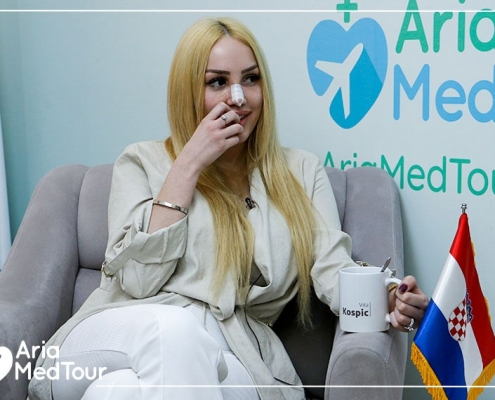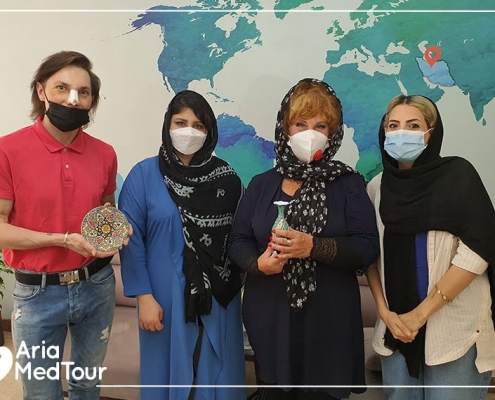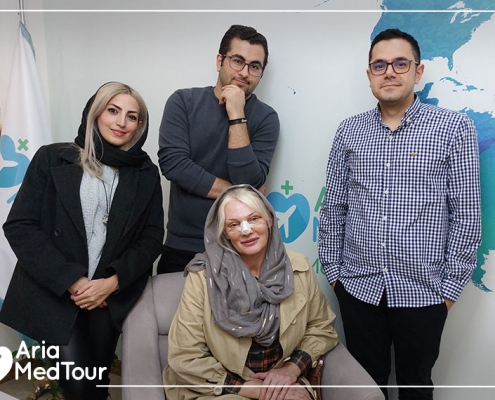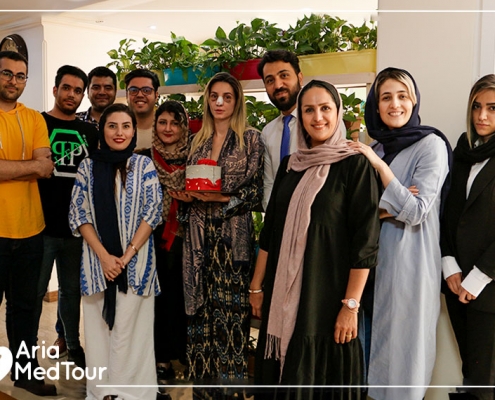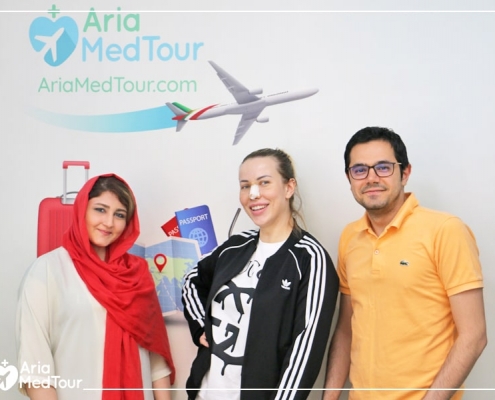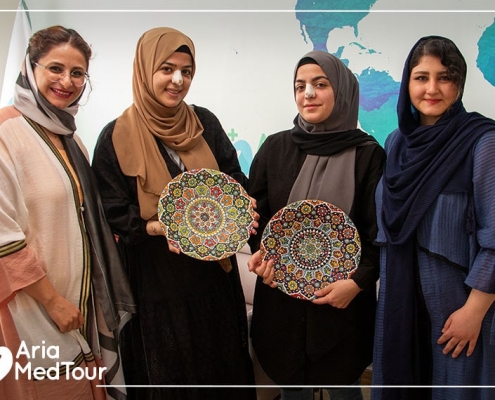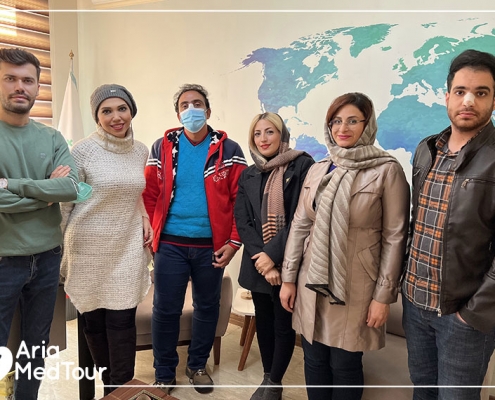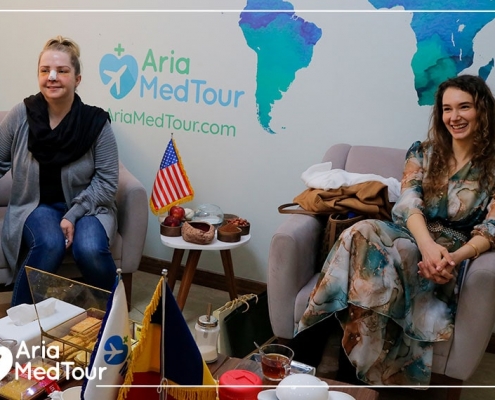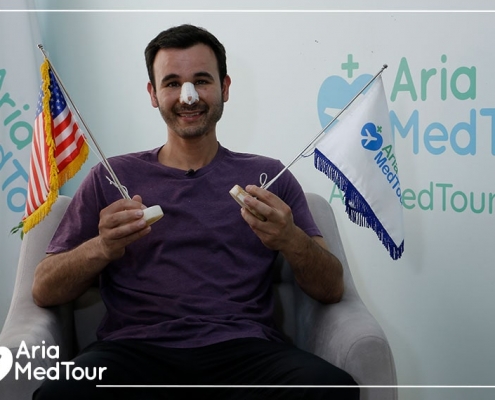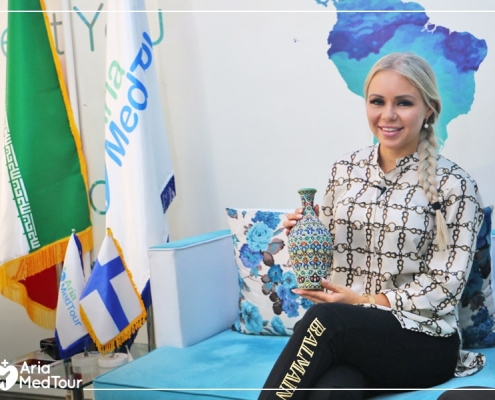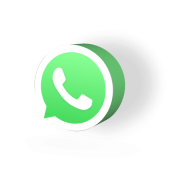Pterygium surgery is performed to remove the abnormal tissue from the cornea and sclera of the eye. The growth of the conjunctiva (the clear tissue covering the white part of the eye and the inside of the eyelids) causes this noncancerous and abnormal tissue, which starts from the corner of the eye, and may slowly grow in a triangular shape. As long as pterygium doesn’t reach the pupil and extend over it to interfere with the vision, surgery is not needed.
But some people want to remove it even in case of little or no symptoms due to cosmetic reasons and regaining a healthy appearance. Pterygium surgery in Iran is one of the surgical eye operations that is performed by competent ophthalmologists with the most modern technologies to make sure it will not grow back again after removing.
Hear about our patients’ experiences in Iran: They have so much to share.
Watch these stories from different patients around the world to see why people choose Iran for their cosmetic surgeries and how AriaMedTour facilitates their medical trip to Iran.
A medical trip documentary:
Crossing borders for a unique beauty adventure
Why choosing Iran for eye care?
Strabismus surgery experience
Femto Lasik success story:
Iraqi patient’s journey to clear vision in Iran
From Iraq with love: A mother’s tale
of her son’s eye surgery in Iran
Haven’t decided yet? Let us help you, it’s free
Who are at risk for developing a pterygium?
(1) As UV (ultra-violet radiation) is the most significant cause of pterygium, this condition is more prevalent in regions that are at exposure to excessive amounts of UV. Thus, people who live in the following places are at higher risk of developing this condition:
- sunny and dry places
- areas in which the depletion of the ozone layer has caused a defect in filtering the UV light
(2) Another factor that may cause the development of pterygium is the exposure of the eye to certain elements, including wind, dust, sand, chemicals, smoke, and air pollution.
We can conclude from 1 & 2 that pterygium is more common in people who work outside, at extra exposure to UV light and the mentioned elements, such as farmers, fishermen, construction workers, in addition to surfers, other water-sport athletes, and snow-sport athletes. Wearing sunglasses or any other eye protection to prevent UV can reduce the possibility of developing the disorder by one fifth.
(3) Pterygium is as twice as prevalent in men as women. A family history of the disorder and genetic factors might increase the possibility of developing this disorder. Also, it is more prevalent in people who are older than 40.
What are the symptoms of Pterygium?
A person may notice the formation of pterygium in the corner of one or both of the eyes, but may not experience any other symptoms. If pterygium causes symptoms, they are usually mild, including:
- Redness of the eye
- Inflammation
- Irritation of the eye
- Dryness of the eye
- Itchiness
- A feeling that there is a foreign object in the eye (if the pterygium is thick or large)
In more severe cases, especially when the pterygium is large enough to extend to the pupil, a person might experience these symptoms:
- Chronic eye irritation
- A burning feeling in the eye
- Astigmatism and blurring of vision
- Obscuring of vision
When is a pterygium surgery necessary?
If the disorder is medically manageable, surgery is not necessary. For minor cases, when the pterygium produces little symptoms such as redness, inflammation, dryness, and significant reduction of tear production, treatment usually involves eye drops, ointment, and lubrication. Topical NSAIDs (nonsteroidal anti-inflammatory drugs) may also help to reduce the pterygium’s appearance.
Surgery for removing pterygium is performed when:
(1) the treatments mentioned above don’t provide relief.
(2) Patient has unmanageable symptoms such as loss of vision, blurry vision, discomfort, and chronic eye irritation.
Also:
(3) Pterygium can affect one’s appearance, therefore some people prefer to remove it for cosmetic reasons. You can discuss it with your doctor or consult with a medical consultant.
Before pterygium surgery
Before pterygium surgery in Iran, an ophthalmologist performs an extensive examination on the patient’s eye, reviews their health history, and gives them general guidelines about the surgery. In case of consuming special drugs such as blood thinners, the patient is asked to stop them for about two weeks before the surgery.
As general anesthesia can cause problems in the stomach, such as nausea, the patient may be asked to fast from the night before surgery.
Also, if the patient wears contact lenses, it may be required to stop using at least twenty-four hours before the surgery.
During the surgery
As a minimally invasive surgery, the length of pterygium removal operation mostly depends on the complexity of each person’s disorder. But it generally takes about half an hour to forty-five minutes.
Pterygium surgery is an outpatient procedure without overnight hospital stay. It can be performed under local or general anesthesia or intravenous sedation to ensure comfort for the patient. Local anesthesia injection is given for numbing the tissues and preventing the patient to feel any pain. After the injection, the eye becomes completely numb, and there is no way to see the surgery occurring or sensing any discomfort.
Techniques of pterygium surgery
(1) Bare sclera technique: A conventional procedure in which the doctor only detaches the pterygium tissue from the eye without replacing it with any other tissue graft. In this case, the underlying white of the eye is left to heal on its own. This technique has a high risk of pterygium re-growth.
(2) AMT: After removing the pterygium, there will be a gap in the conjunctiva, and the doctor will fill it with amniotic membrane transplantation (AMT).
(3) Free conjunctival autograft: The gap will be filled with a transplant of tissue that has been painlessly detached from underneath the upper eyelid.
Although there are some other techniques, the second and third methods have shown a lower rate of risks for re-growth, especially the third one, and it is the main technique used in pterygium surgery in Iran.
To secure AMT or graft in its place on the eye and avoid movement, two methods are applied: using sutures and fibrin glue. While stitches can cause discomfort for several weeks, glue, compared to suture, reduces inflammation and discomfort and reduces the recovery time.
Risks of pterygium surgery
There are a couple of risks associated with every operation. As for the pterygium surgery, like any other surgery, there is a minor possibility for bleeding and infection. Also, in case of using fibrin glue, since it is a blood-derived product, it may carry the risk of transmitting viral infections and diseases.
But the most important risk for this surgery is the return of pterygium after being removed. Although the recurrence is not very common and it only happens in a small percentage of cases (men experience it more than women), the surgeon needs to do follow-up examinations, as it may reappear between 2 and 6 months after surgery. The recurrence of pterygium is highly related to the size of the removed pterygium (less than 5 mm of base width has a lower chance of recurrence), as well as the competency of the surgeon, and the operation method. It can be controlled by medications and eye drops to prevent growing back, but in some cases, a second surgery is needed. As the most competent doctors do the pterygium surgery in Iran with the best methods, the chances of recurrence are extremely low.
Pterygium surgery cost in Iran
Although Iran’s healthcare system has been rated as excellent by UNICEF, and it has a high rate of cosmetic procedures, the price of medical procedures, compared to other countries, is not high. This is due to economic reasons, which makes the cost of travel, surgery, and other services more affordable than in other countries. Therefore, pterygium surgery prices in Iran are lower than other countries. Feel free to contact us for more information about the cost of pterygium surgery in Iran.
Recovery from the pterygium surgery
After the surgery, an eye patch or pad is used to cover the eye and prevent infection or dislodging the attached tissue by rubbing the eye. Usually, the patients spend at least one day resting with their heads elevated on a pillow. Sometimes, ice packs are used to reduce swelling.
After any surgical procedure, some discomfort can be expected, and pterygium surgery is not an exception either. some patients experience a dull headache, discomfort, and temporary numbness after the surgery. It is normal for patients to feel some redness, dryness, or discomfort a few days after the operation. Having bruising and swelling for a few days is normal as well. They also might experience some blurriness during recovery.
The recovery time for each person is different. The type of technique used in surgery might affect the healing time, as well. But it usually takes a couple of weeks to a couple of months for a person to completely heal. And based on the medical history and physical health, patients can go back to work one week after the surgery or sooner. They can start watching TV, using a computer, or reading within 1-2 days after pterygium surgery.
Patients are not allowed to participate in any exercise programs including aerobic for at least two weeks. They mustn’t use contact lenses for at least two weeks after surgery, as well, and they should consult with their doctor before using them again.
Also, patients need to be examined one day and one week after the surgery. Other examinations during the first year are needed to make sure the conjunctiva isn’t growing back.
Contact Our Medical Support Team:


